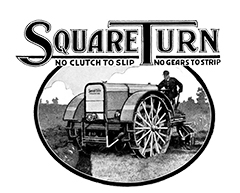1917 Square Turn 18-35
The Square Turn was a progressive, unique tractor for its time. Conceived by two Nebraska men, Norfolk farmer A.T. Kenney and Chicago & Northwestern Railroad employee A.J. Colwell, it seemed perfectly designed for farm use. Kenney was a successful farmer and Colwell had 14 years of experience as superintendent of construction on the C&NW Railroad. With Colwell supplying mechanical genius and Kenney providing practical farming experience, the two men formed the Kenney-Colwell Co. of Norfolk, Nebraska.
Nancy Zaruba and Karen Rogat in their booklet, Norfolk’s Very Own Square Turn Tractor , wrote: “The two inventors worked untiringly in the shop and in the field until they had produced a one-man tractor that would turn short and square, that would get close to the fence corners, that would carry the plows below and in full view of the operator, and that would handle as easily as any team [of horses].” 
By the time a prototype was completed in 1915, the Kenney-Colwell Co. had received eight patents for its Square Turn. Almost as soon as the prototype was built, Kenny and Colwell realized they were not qualified to manufacture the tractor. In 1916, the patents for the Square Turn were sold to Albaugh-Dover Co. The Square Turn Tractor Co. was organized in December 1917 with headquarters in Chicago. The manufacturing operation remained in Norfolk.
Unfortunately, the steel rationing of World War I, followed by an agricultural depression, were challenged the company could not overcome. The firm was able to produce nothing more than demonstration models, and customers demanded refunds of cash deposits they had paid. With all these pressures and challenges, Albaugh-Dover was forced into bankruptcy. The patents and factory reverted to Kenny and Colwell, who continued production until 1925 when the factory was closed and sold at a sheriff’s sale.
The Square Turn tractor could stop and turn around in its own tracks. Its three-wheel design let it operate in either direction. An engine-powered lift raised and lowered its three-bottom plow. The easiest way to get it started was with another tractor. Because 70 percent of the machine’s weight sat above the drive wheels, the tractor had excellent traction. A farmer could plow right up to a fence and make tight turns previously possible only when farming with horses. The Square Turn was also advertised as having “a real power lift, operated direct from the engine, raising or lowering the plows at a touch of the foot even when the engine is idling.”
Although its system of levers, pedals, and wheels looked daunting, it was said a man could learn to operate it in 10 minutes. It “handled as easily as a team” yet could easily beat three to five teams of horses traveling at three to four miles an hour. For ease in turning, the driver’s seat pivoted 180 degrees. Advertisements promoted the fact the tractor’s unique design eliminated a number of common problems. It had fewer parts than other tractors, it carried the plow and other tools in full view of the operator, and it worked on hills and low land where most tractors could not operate.
With all its innovations and claims, the primary selling point of the three-wheeled tractor was its unique ability to turn “around in its own length” in five seconds. This was accomplished, not by its steering wheel, but by its transmission’s ability to instantly cause one driving wheel to revolve in one direction whiles the other, independently, turned in the opposite direction.
Only about 700 Square Turn tractors were made from around 1917 to 1925, and fewer than five Square Turn tractors are believed to still exist today.